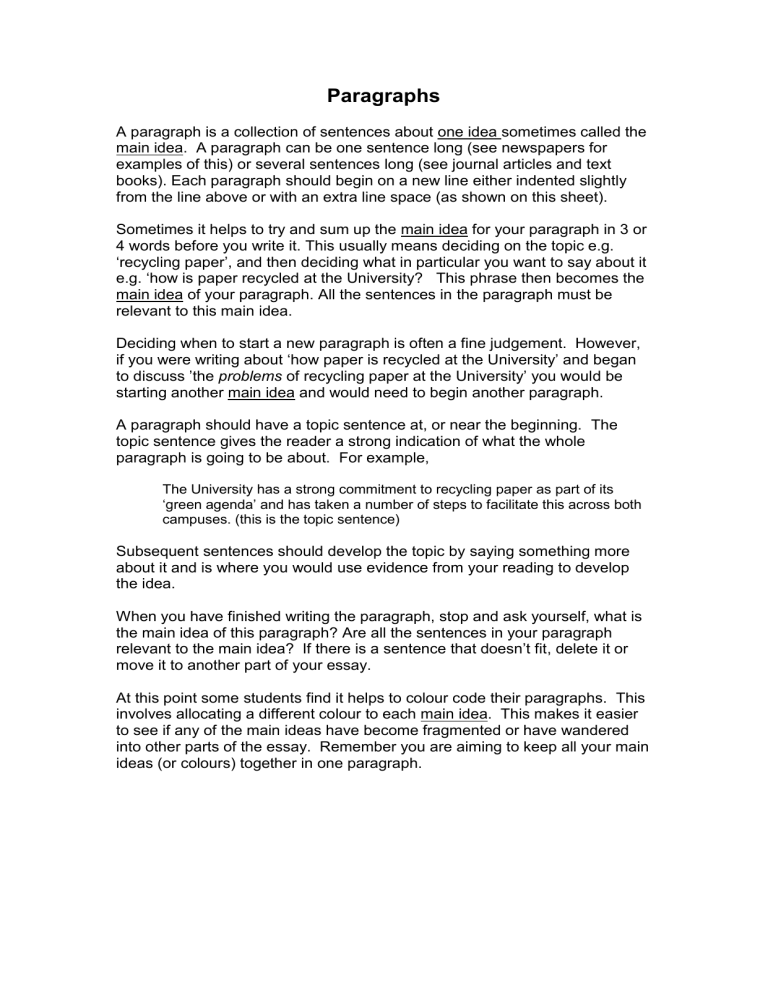Guide to Writing and Linking Paragraphs

Paragraphs
A paragraph is a collection of sentences about one idea sometimes called the main idea. A paragraph can be one sentence long (see newspapers for examples of this) or several sentences long (see journal articles and text books). Each paragraph should begin on a new line either indented slightly from the line above or with an extra line space (as shown on this sheet).
Sometimes it helps to try and sum up the main idea for your paragraph in 3 or
4 words before you write it. This usually means deciding on the topic e.g.
‘recycling paper’, and then deciding what in particular you want to say about it e.g. ‘how is paper recycled at the University? This phrase then becomes the main idea of your paragraph. All the sentences in the paragraph must be relevant to this main idea.
Deciding when to start a new paragraph is often a fine judgement. However, if you were writing about ‘how paper is recycled at the University’ and began to discuss ’the problems of recycling paper at the University’ you would be starting another main idea and would need to begin another paragraph.
A paragraph should have a topic sentence at, or near the beginning. The topic sentence gives the reader a strong indication of what the whole paragraph is going to be about. For example,
The University has a strong commitment to recycling paper as part of its
‘green agenda’ and has taken a number of steps to facilitate this across both campuses. (this is the topic sentence)
Subsequent sentences should develop the topic by saying something more about it and is where you would use evidence from your reading to develop the idea.
When you have finished writing the paragraph, stop and ask yourself, what is the main idea of this paragraph? Are all the sentences in your paragraph re levant to the main idea? If there is a sentence that doesn’t fit, delete it or move it to another part of your essay.
At this point some students find it helps to colour code their paragraphs. This involves allocating a different colour to each main idea. This makes it easier to see if any of the main ideas have become fragmented or have wandered into other parts of the essay. Remember you are aiming to keep all your main ideas (or colours) together in one paragraph.
Linking ideas
Certain words are used to link ideas and to signpost to the reader the direction your line of reasoning is about to take, such as adding emphasis or introducing an alternative viewpoint. Below is a selection of words used to link ideas depending on the direction of your argument.
Adding more to a point
also; moreover; furthermore; again;
further; what is more; then; in addition
besides; above all; too; as well (as) either; neither….nor; not only…but also; similarly; correspondingly; in the same way; indeed
in fact; r eally; in reality, it is found that…
as for; as to ; with respect to; regarding
Introducing an alternative viewpoint
by contrast; another way of viewing this is; alternatively; again; rather; one alterative is; another possibility is;
on the one hand…on the other hand
conversely; in comparison; on the contrary; in fact; though; although
Returning to emphasise your earlier viewpoint
however; nonetheless; in the final analysis Writing in lists
first(ly); second(ly); third(ly);
another; yet another; in addition; finally
to begn with ; in the second place;
moreover; additionally; also
next; then; and to conclude; lastly; finally
Putting the same idea in a different way
in other words; rather; or; better; in that case
to put it (more) simply
in view of thyis; with this in mind
to look at this another way
despite x; notwithstanding x; in spite of x
while x may be true, nonetheless
although; though; after all; at the same time; on the oother hand; all the same; eve if x is true; although x may have a good point
Showing the results of something
therefore; accordingly; as a result
so, (then) it can be seen that
the result is; the consequence is
resulting from this; consequently; now
we can see then, that; it is evident that
because of this; thus; hence; for this reason
Introducing examples
that is to say; in other words
for example; for instance; namely; an example of this is
and; as follows; as in the following examples; such as; including
especially particularly; in particular; notably; chiefly; mainly; mostly
owing to x; this suggests that; it follows that
in other words; otherwise; in that case; that implies
Summing up or concluding
therefore; so, my conclusion is
in short; in conclusion; to conclude; in all; on the whole
to summarise; to sum up briefly; in brief; altogether; overall; thus; thus we can see that
Taken from Cottrell, S (1999) The Study Skills Handbook, Macmillan Press Limited








